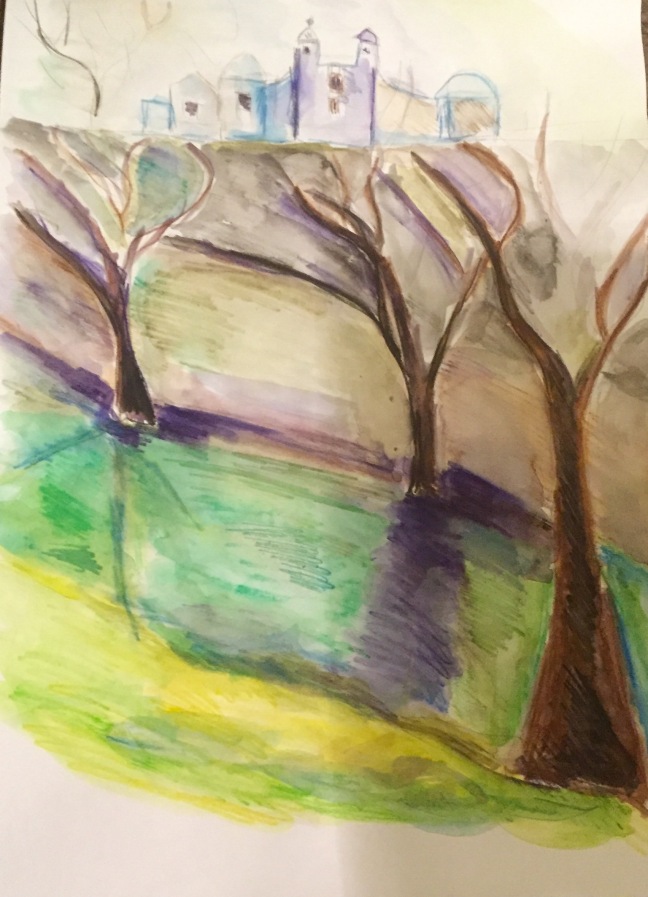The urban environment has become a theme that has inspired and captured many contemporary artists. For some artists it allows them the revisit the historical concept of ‘landscape but to also offer an insight into today’s fast and changing society. The aftermath of two world wars that saw a shift in the class system that changed society. Also urbanisation and industrialisation changed how landscape is perceived and a new kind of landscape evolved in the towns. artists like L.S Lowry depicted everyday scenes of workers and factories. Artists began to focus on the urban environment.
John Virtue was born in Lancashire in 1947 and as a landscape artist the focus of his work is to capture the landscape where he lives. Virtue seems to very concerned with what he sees as his own landscape and what it means to him rather than recording just a picture of the scene. In 2002 Virtue moved his studio to London and used for his inspiration the urban landscape from walks around the Southbank area of London- taking the buildings uncounted on the route as the source of his inspiration. Each work starts from rapid mainly linear sketches done on location. Some of the locations of these sketches have been on rooftops including the roof of the National gallery. These sketches are used as a visual diary to produce large scale monochromatic works. Virtue uses black ink mixed with shells and white acrylic paint onto an unprimed canvas. The effect is very emotionally charged , bleak and visceral. The work has energy and atmosphere. The media is worked and edited as part of the process – the composition is shifted as the work evolves .Virtue is not concerned with capturing everything he makes decisions about what to include leaving out any cranes, buses and other means of transport. I particularly like the way Virtue is able to make decisions to be in control of his art and how he evaluates and re-works as the images are formed.
Frank Auerbach ( b. 1931) also finds inspiration from his urban surroundings. From the 1950’s Auerbach has produced urban street scenes from the locality close to his studio in North London. ‘ this part of London is my world I’ve been wandering around these streets for so long that I’ve become attached to them …’ ( source of quote Tate gallery online). So like Virtue Auerbach finds inspiration in the familiarity of his surroundings.
some contemporary artists explore use their surroundings in their art to explore their culture , loss of their world and politics. William Kentridge ( b.1955) is a figurative artist that was born in South Africa during a very turbulent time in its post war history. Kentridge is known for his prints, monochromatic drawings and film making. Kentridge starts the process off by producing several charcoal drawings which changes, rubs out and over draws on before photographs each of the stages onto 16 or 35mm film. The principle theme is the depiction of human processes both in a physical and a political sense that is enacted on to the landscape.
Julie Mehretu ( b.1970 in Ethiopia) is an American abstract artist that uses her work to give a message. Mehretu uses her work to describe the almost fractured world though layers and fragments to engage with important issues such as migration and how the modern urban city is transforming. Mehretu has an interesting drawing technique she works on architect vellum laying images such as weather maps, plans and sport stadiums. On top Mehretu adds marks , lines and arrows.
To conclude when researching the urban environment it became clear to me that as a theme for today’s artists it is used in a number ways – to explore culture and identity, to express emotions , to spread a topical message and to record change. All of the artists that I looked at seemed to have their own unique take on urban environment and what it means to them as an individual. It clearly is an constantly evolving genre that can offer a personal insight to artistic identify.
SOURCES
ab-artmag.com
bombmagazine.org/article/julie-mehretu
http://www.nationalgallery.org.uk
BOOK
Drawing now : eight proposition by Laura Hoptman
published by Museum of modern art NY
Isbn 978-0-87070-362-1










 for this exercise the instructions is to either work from a sketch or photograph or work on location. I decided to go outdoors to draw. It was a chilly March morning so I worked fairly quickly.
for this exercise the instructions is to either work from a sketch or photograph or work on location. I decided to go outdoors to draw. It was a chilly March morning so I worked fairly quickly.




























